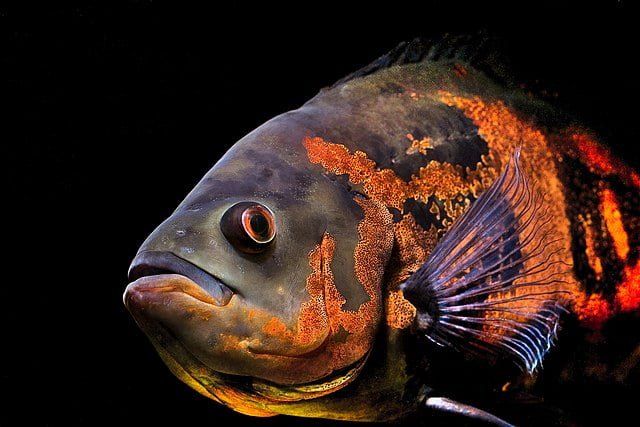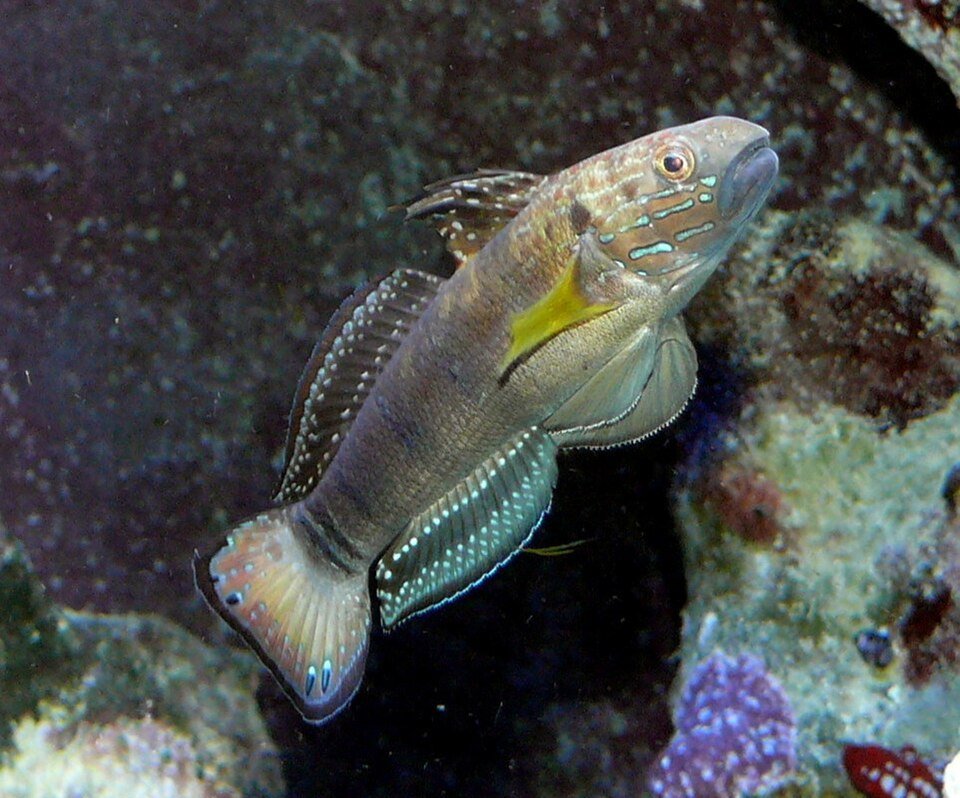
The Clown Killifish (Epiplatys annulatus), also known as killi payaso in Spanish, is a small freshwater fish that has gained popularity among aquarists due to its vibrant coloration and intriguing behavior.
This article will guide you through everything you need to know about caring for Clown Killifish, including their water parameters, diet, breeding, differences between males and females, and much more.
Characteristics of the Clown Killifish
Taxonomy
- Kingdom: Animalia
- Phylum: Chordata
- Class: Actinopterygii
- Order: Cyprinodontiformes
- Family: Nothobranchiidae
- Genus: Epiplatys
- Species: Epiplatys annulatus (Boulenger, 1915)
- Synonyms: Haplochilus annulatus (Boulenger, 1915); Aplocheilus annulatus (Boulenger, 1915); Panchax annulatus (Boulenger, 1915); Pseudepiplatys annulatus (Boulenger, 1915)
- Common name in Spanish: Killi payaso, pez-almirante bandeado
- Common name in English: Clown Killifish, Clown Killi, Banded Admiral Fish
The Clown Killifish, also known as the Banded Admiral Fish, is a small but striking species native to West Africa. Its scientific name, Epiplatys annulatus, refers to the rings or bands that adorn its body, giving it a very distinctive appearance; the word “killi” in its common name refers to the ditches or channels where they are found.
Physical Characteristics of the Clown Killifish
The lifespan of the Clown Killifish (Epiplatys annulatus) under ideal conditions can range from 2 to 3 years, although this may vary depending on the quality of care they receive.
The Clown Killifish has an elongated body and can reach a maximum length of 3.0 cm. The fish’s body color is light cream with four thick black stripes. Additionally, Epiplatys annulatus has 7 rays in the dorsal fin and 13 rays in the anal fin.
Natural Habitat of the Clown Killifish
The natural habitat of the Clown Killifish (Epiplatys annulatus) includes the swampy areas of Sierra Leone, Guinea, and Liberia.
This fish lives in small schools, where there is a dominant male. It prefers dark environments with dense vegetation and shallow water.
Care of the Clown Killifish
Caring for a Clown Killifish is not particularly difficult, but it does require attention to specific details to ensure their well-being. These fish are peaceful and can live in small aquariums, making them ideal for small spaces. However, the aquariums where you keep your fish should have a lid, as the Clown Killifish is known to be a “jumping fish.”
Stay Always Informed
Join our communities to instantly receive the most important news, reports, and analysis from the aquaculture industry.
Table 01. Water Quality Parameters for Raising Clown Killifish (Epiplatys annulatus).
| Parameter | Range |
| Aquarium Water Volume | 20 liters for 2 fish |
| Water Temperature | 22-26°C (72-79°F) |
| Water pH | 6.0-7.5 |
| Water Hardness | 1 – 3 GH2 – 4 KH |
| Ammonia/Nitrite Levels | 0 |
| Nitrates | <50 ppm |
| Water Current Speed | Slow |
| Water Renewal | 20 – 30% per month |
I recommend using water test kits to regularly monitor pH levels, hardness, and other important parameters. It is vital to make immediate adjustments if you notice any drastic changes. You may need to adjust the water parameters depending on the water source you use; here are some tips:
- Water Softening: If your tap water is hard, you can use peat or add distilled water to soften it.
- pH Regulation: The use of Indian almond leaves or specific additives can help you maintain the pH within the ideal range.
- Vegetation: It is recommended to include plenty of plants like Java moss or Riccia.
What Do Clown Killifish Eat?
In their natural habitat, Clown Killifish feed on small crustaceans, mosquitoes near the surface and their larvae, as well as small ants, spiders, and other tiny insects (Silvo, 2020).
In captivity, the diet of Clown Killifish should be varied and rich in protein to maintain their bright colors and high energy.
Recommended Food Types
- Live Food: Clown Killifish prefer live food such as daphnia, brine shrimp, and small worms. These not only provide nutrition but also stimulate their natural hunting behavior. You can download a manual for live food production to provide your fish with a complete diet.
- Frozen Food: These can be offered as an alternative to live food; make sure to thaw them completely before feeding.
- Dry Food: Although they accept flakes and small pellets, these should be high-quality and specifically formulated for carnivores to ensure the fish get all the necessary nutrients.
It is recommended to feed them twice a day in small amounts to avoid leftover food contaminating the water.
Feeding Fry and Juveniles
Caring for Clown Killifish doesn’t end with the birth of the fry. Their feeding during this stage is critical to ensuring healthy growth.
First Days
Newly hatched fry require small live food such as infusoria. As they grow, they can be fed with brine shrimp nauplii and microworms.
Transition to Adult Food
Once the fry reach an appropriate size, you can gradually introduce adult food, ensuring it is small enough for them to eat.
How to Breed Clown Killifish
Breeding Clown Killifish can be a rewarding experience. Here is a step-by-step guide to the process.
Differences Between Male and Female Clown Killifish
Identifying the differences between male and female Clown Killifish is essential, especially if you plan to breed them.
- Males: Males are usually more vibrant in color, with longer and more decorative dorsal and caudal fins. Additionally, the color bands on their bodies are more intense.
- Females: Females are generally less colorful and have shorter, rounder fins. Their bodies are more robust, especially when filled with eggs.
Behavior
- Males: They tend to be more territorial and active, displaying their fins to attract females or deter other males.
- Females: They are calmer and spend most of their time foraging or resting among the plants.
Preparing the Aquarium for Breeding
- Aquarium: A 10-liter tank is sufficient for a breeding pair. However, it is recommended to include 1 male and 2 females. Ensure that the water quality is adequate and that the parameters are ideal for breeding these fish.
- Floating Plants: These provide a natural environment for Clown Killifish to lay their eggs. Fine-leafed plants like Java moss or Riccia are ideal.
Breeding Process
Clown Killifish are egg scatterers, laying eggs less than 1 mm in diameter among floating plants, particularly near the surface.
- Pair Selection: Place a male and a female together in the breeding tank. The male will court the female by displaying his fins and swimming in a zigzag pattern.
- Spawning: Once the female is ready, she will deposit the eggs among the plants. The male will fertilize them immediately.
- Removing the Adults: Once spawning is complete, it is important to remove the adults from the tank to prevent them from eating the eggs.
Caring for the Fry
The fry hatch after about 10-14 days.
- Feeding: The fry are very small and require microscopic food such as infusoria during the first days. As they grow, they can be fed brine shrimp nauplii.
- Water Changes: Perform regular water changes to maintain high water quality, but ensure these changes are gradual to avoid disturbing the delicate fry.
Clown Killifish Compatibility
The Clown Killifish is a peaceful fish that can coexist with other species in a community aquarium, as long as they are equally peaceful and do not see it as prey.
Compatible Species
- Small Tetras
- Dwarf Corydoras
- Neocaridina Shrimp
Species to Avoid
- Large or aggressive fish: like cichlids, which may see the Clown Killifish as prey.
- Long-finned fish: may compete with or harass the Clown Killifish.
Conclusion
The Clown Killifish (Epiplatys annulatus) is a fascinating species that offers a lot to aquarists, from its colorful display to the excitement of breeding them. With proper care, these small fish can thrive and brighten any aquarium with their vibrant presence.
By integrating what you’ve learned about the differences between males and females, water parameters, feeding, and breeding, you’ll be well-equipped to care for your Clown Killifish and enjoy all that these fish have to offer. This article provides a solid foundation for becoming an expert in managing this species, ensuring a satisfying and successful experience in breeding Clown Killifish.
References
American Killifish Association
Silvo Viforcos José A. 2020. Pseudepiplatys annulatus: Mi experiencia en el mantenimiento del killi payaso. Revista Argos No 13.
Editor at the digital magazine AquaHoy. He holds a degree in Aquaculture Biology from the National University of Santa (UNS) and a Master’s degree in Science and Innovation Management from the Polytechnic University of Valencia, with postgraduate diplomas in Business Innovation and Innovation Management. He possesses extensive experience in the aquaculture and fisheries sector, having led the Fisheries Innovation Unit of the National Program for Innovation in Fisheries and Aquaculture (PNIPA). He has served as a senior consultant in technology watch, an innovation project formulator and advisor, and a lecturer at UNS. He is a member of the Peruvian College of Biologists and was recognized by the World Aquaculture Society (WAS) in 2016 for his contribution to aquaculture.




